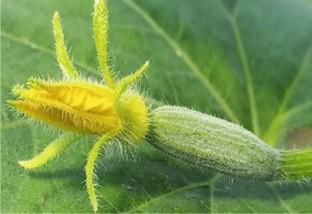In Vitro Cellular & Developmental Biology - Plant ( IF 2.6 ) Pub Date : 2024-01-25 , DOI: 10.1007/s11627-023-10406-9 Fildaus Nyirahabimana , İlknur Solmaz

|
Haploidization technique is the modern and advanced breeding technique used to enhance economically essential crops, including cucumber, to meet consumers’ preferences and needs worldwide. This study aimed to evaluate the effects of factors such as genotype, thermal pre-treatments, and nutrient medium combinations that are considered in haploid production via ovary culture in four commercial cucumber varieties. Four different induction media with four distinct maturation medium combinations and three F1 and one open-pollinated (Beith Alpha) cucumber varieties were used. All explants (cucumber ovaries’ slices) were inoculated in induction media and remained at 35 °C/3 d in the dark, then were transferred at 25 ± 1 °C 16-/8-h light/dark photoperiod for a further 9 d. The results of the study demonstrated that the embryo-like structure (ELS) formation rate was high in induction medium 2 which was successful in all varieties of Ptk40 (20%), Botanik (20%), Beith Alpha (16%), and Sardes (13.3%), respectively, compared to other induction medium combinations used in this study. Callus formation rates obtained from regeneration of medium 2 supplemented with 2.0 mg L−1 6-benzylaminopurine (BAP) and 0.5 mg L−1 1-naphthaleneacetic acid (NAA) were Ptk40 (65%), Sardes (60%), and Botanik (40%), and no callus was formed in Beith Alpha. Due to the findings of this study, the nutrient medium containing KIN and 2,4-D seems to be successful during induction of haploid embryo formation in cucumbers. One plantlet germinated but perished at early stage. The plantlet regeneration was observed to be low. Further studies are required to optimize the embryo regeneration medium composition due to the cucumber growing seasons, genotypes, and nutrient medium.
中文翻译:

通过黄瓜卵巢培养诱导单倍体
单倍体化技术是一种现代先进的育种技术,用于增强包括黄瓜在内的经济必需作物,以满足全球消费者的偏好和需求。本研究旨在评估基因型、热预处理和营养培养基组合等因素对四个商业黄瓜品种通过子房培养产生单倍体的影响。使用四种不同的诱导培养基和四种不同的成熟培养基组合以及三种F1和一种开放授粉(Beith Alpha)黄瓜品种。所有外植体(黄瓜卵巢切片)均接种在诱导培养基中,并在黑暗中保持在35°C/3天,然后在25±1°C 16-/8-h光照/黑暗光周期下再转移9天。研究结果表明,诱导培养基 2 中的类胚结构 (ELS) 形成率很高,在 Ptk40 (20%)、Botanik (20%)、Beith Alpha (16%) 和 Beith Alpha (16%) 的所有品种中均获得成功。与本研究中使用的其他诱导培养基组合相比,Sardes 分别为 13.3%。从补充有 2.0 mg L -1 6-苄氨基嘌呤 (BAP) 和 0.5 mg L -1 1-萘乙酸 (NAA) 的培养基 2 再生获得的愈伤组织形成率为 Ptk40 (65%)、Sardes (60%) 和 Botanik (40%),Beith Alpha 中没有形成愈伤组织。根据这项研究的结果,含有 KIN 和 2,4-D 的营养培养基似乎在诱导黄瓜单倍体胚胎形成过程中取得了成功。一株幼苗发芽但早期死亡。观察到植株再生率较低。由于黄瓜生长季节、基因型和营养培养基的原因,需要进一步研究来优化胚胎再生培养基的组成。



























 京公网安备 11010802027423号
京公网安备 11010802027423号